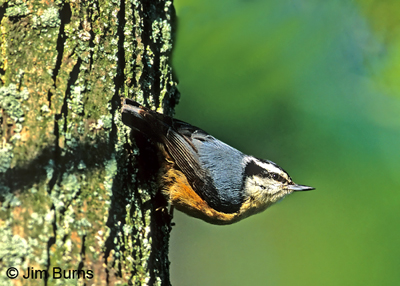
Janet Witzeman and Troy Corman, in their smashing new edition of Birds of Phoenix and Maricopa County Arizona, call Red-breasted Nuthatch a “rare and local resident at higher elevation pine forests” and an “irregular fall transient . . . in lowlands.” This was a new yardbird for us, certainly unanticipated here and unexpected anywhere in the Valley. Except in years when those vicious mountain marauders decide to so cruelly “invade” us.
So . . . here we go with some terminology, and I am not the expert, only the reporter. “Migration” refers to regular seasonal movements, and there are two kinds—latitudinal and altitudinal. Many North American birds fly to Central and South America for the winter, and some North American birds that breed at high altitudes move to lower altitudes for the winter. Because we tend to be geographically arrogant, we think of the former as “our” birds, but they actually spend more time in southern latitudes avoiding our preyless cold season than they do with us in their breeding raiment. But that’s the subject of another column.
“Invasion,” not the same as “migration” but often used synonymously with “irruption,” should be used only to refer to permanent range extensions of birds. So, strictly speaking, we’re not being “invaded” by mountain birds this year, but we were “invaded" last century by Great-tailed Grackles and this century by Eurasian Collared-Doves.
Before we settle in on “irruption” though, there is another distinction to be made between that term and “eruption.” The latter refers to movement from a specific habitat, whereas the former is used for movement into a different habitat. Yes, here in the desert this winter we’ve had an “irruption” of mountain species, and this is typically noticed and thusly labeled because more birders live here than on top of Pinal Peak. If you lived up there, I guess you’d say you had an “eruption” of Red-breasted Nuthatches. They all left and went somewhere else.
Why they left and where they went is dictated by periodic fluctuations in rather restrictive food preferences. Thus the most frequently irruptive families of birds are hawks, owls, and the ones that depend heavily on the pine crops of our coniferous forests. This last category would include our Red-breasted Nuthatch as well as various jays, chickadees, grosbeaks, finches, and woodpeckers like the Lewis’s Woodpecker which many Valley birders observed this winter transferring acorns from the oaks in Scottsdale Ranch Park to its cache in nearby neighborhood Fan Palms. Lewis’s Woodpecker and desert Fan Palms is another birding oxymoron and that will be the subject of my next column.
In the meantime, enjoy whichever birds still linger here in the lowlands after their recent winter “eruption” from the mountains. And remember, if you use a word whose exact nuance in a sentence may catch the reader off guard or may be used tongue in cheek, put it in quotes. Or use “air” quotes with it in verbal conversations.